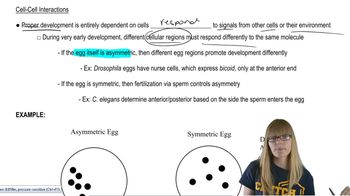Table of contents
- 1. Introduction to Genetics51m
- 2. Mendel's Laws of Inheritance3h 37m
- 3. Extensions to Mendelian Inheritance2h 41m
- 4. Genetic Mapping and Linkage2h 28m
- 5. Genetics of Bacteria and Viruses1h 21m
- 6. Chromosomal Variation1h 48m
- 7. DNA and Chromosome Structure56m
- 8. DNA Replication1h 10m
- 9. Mitosis and Meiosis1h 34m
- 10. Transcription1h 0m
- 11. Translation58m
- 12. Gene Regulation in Prokaryotes1h 19m
- 13. Gene Regulation in Eukaryotes44m
- 14. Genetic Control of Development44m
- 15. Genomes and Genomics1h 50m
- 16. Transposable Elements47m
- 17. Mutation, Repair, and Recombination1h 6m
- 18. Molecular Genetic Tools19m
- 19. Cancer Genetics29m
- 20. Quantitative Genetics1h 26m
- 21. Population Genetics50m
- 22. Evolutionary Genetics29m
17. Mutation, Repair, and Recombination
Types of Mutations
Problem 4d
Textbook Question
Why would a mutation in a somatic cell of a multicellular organism not necessarily result in a detectable phenotype?
 Verified step by step guidance
Verified step by step guidance1
Understand that somatic cells are any cells forming the body of an organism, excluding germ cells (sperm and egg).
Recognize that mutations in somatic cells are not passed on to offspring, as they do not affect the germ line.
Consider that a mutation in a single somatic cell may not affect the organism if the cell is not critical to the organism's function or if the mutation does not alter the cell's function significantly.
Realize that many somatic mutations are neutral, meaning they do not affect the cell's function or the organism's phenotype.
Acknowledge that the organism has many cells, and a mutation in one or a few cells may be masked by the normal function of the remaining healthy cells.
 Verified video answer for a similar problem:
Verified video answer for a similar problem:This video solution was recommended by our tutors as helpful for the problem above
Video duration:
30sPlay a video:
Was this helpful?
Key Concepts
Here are the essential concepts you must grasp in order to answer the question correctly.
Somatic Cells
Somatic cells are any cells in a multicellular organism that are not germ cells (sperm or egg). They make up the majority of an organism's body and undergo mitosis for growth and repair. Mutations in somatic cells can occur without affecting the organism's overall phenotype, especially if they happen in non-coding regions of DNA or in cells that do not contribute to the organism's visible traits.
Recommended video:
Guided course

Cell-cell interactions
Mutation Types
Mutations can be classified into several types, including silent, missense, and nonsense mutations. Silent mutations do not change the amino acid sequence of a protein, while missense mutations may alter a single amino acid, and nonsense mutations create a premature stop codon. A mutation in a somatic cell may not lead to a detectable phenotype if it is silent or occurs in a non-essential gene.
Recommended video:
Guided course

Mutations and Phenotypes
Phenotype Expression
Phenotype refers to the observable characteristics of an organism, which result from the interaction of its genotype with the environment. Not all genetic changes lead to visible traits; some may be compensated for by other genes or may not affect the organism's function. Therefore, a mutation in a somatic cell may not manifest as a detectable phenotype if it does not influence the organism's overall appearance or health.
Recommended video:
Guided course

Penetrance and Expressivity





